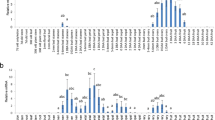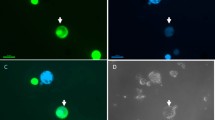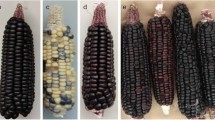Abstract
Petunia hybrida is one of the classical subjects of investigation in plants in which the pathway of anthocyanin biosynthesis has been analysed genetically and biochemically. In petunia cyanidin- and delphinidin-derivatives, but no pelargonidin-derivatives are produced as pigments. This is due to the substrate specificity of the dihydroflavonol 4-reductase of petunia, which cannot reduce dihy-drokaempferol. The petunia mutant RL01, which accumulates dihydrokaempferol, shows no flower pigmentation. RL01 served as a recipient for the transfer of the A1 gene of Zea mays encoding dihydroquercetin 4-reductase, which can reduce dihydrokaempferol and thereby provided the intermediate for pelargonidin biosynthesis. Transformation of RL01 with a vector p35Al, containing the A1 -complementary DNA behind the 35S promotor leads to red flowers of the pelargonidin-type. Thus a new flower pigmentation pathway has been established in these plants.
This is a preview of subscription content, access via your institution
Access options
Subscribe to this journal
Receive 51 print issues and online access
$199.00 per year
only $3.90 per issue
Buy this article
- Purchase on Springer Link
- Instant access to full article PDF
Prices may be subject to local taxes which are calculated during checkout
Similar content being viewed by others
References
1. Heller, W., Forkmann, G., Britsch, L. & Grisebach, H. Planta 165, 284-287 (1985). 2. Forkmann, G. & Ruhnau, B. Z. Naturforsch. 42c, 1146-1148 (1987). 3. Cornu, A., Paynot, M. & Touvin, H. Phytochemistry 13, 2022 (1974). 4. Stotz, G., de Vlaming, P., Wiering, H., Schramm, A. W. & Forkmann, G. Theor. appl. Genet. 70, 300-305 (1985). 5. Stotz, G. thesis, Univ. Tubingen (1983). 6. Forkmann, G., de Vlaming, P., Spribille, R. & Schram, A. W. Z. Naturforsch. 41c, 179-186 (1986). 7. Wiering, H. & de Vlaming, P. in Petunia Monograph (ed. Sink) 49-67 (Springer, Berlin, 1984). 8. Schwarz-Sommer, Z. et al. EMBO J. 2, 287-294 (1987). 9. Reddy, A. R., Britsch, L., Salamini, F., Saedler, H. & Rohde, W. PI. Sci. 52, 7-12 (1987). 10. Meyer, P., Walgenbach, E., Bussmann, K., Hombrecher, G. & Saedler, H. Molec. gen. Genet. 201, 513-518 (1985). 11. Harborne, J. B. Comparative Biochemistry of the Flavonoids (Academic, London & New York, 1967). 12. Main, R. et al. Molec. gen. Genet. 199, 161-168 (1985). 13. Shilito, R. D., Paszkowski, I. & Potrykus, I. PL Cell Rep. 2, 244-247 (1983). 14. Binding, H. Z. Pflanzenphysiol. 74, 327-356 (1974). 15. Murashige, T., Skoog, F. Physiol. PI. 15, 473-497 (1962). 16. Logemann, J., Schell, J. & Wilmitzer, L. Analyt. Biochem. 163, 16-20 (1987). 17. Feinberg, A. P. & Vogelstein, R. Analyt. Biochem. 132, 6-13 (1983). 18. Feinberg, A. P. & Vogelstein, R. Analyt. Biochem. 137, 266-267 (1987).
Author information
Authors and Affiliations
Rights and permissions
About this article
Cite this article
Meyer, P., Heidmann, I., Forkmann, G. et al. A new petunia flower colour generated by transformation of a mutant with a maize gene. Nature 330, 677–678 (1987). https://doi.org/10.1038/330677a0
Received:
Accepted:
Issue Date:
DOI: https://doi.org/10.1038/330677a0
This article is cited by
-
The effect of different LED wavelengths on the components and biosynthesis of isoflavonoid in sprout Astragalus membranaceus
Protoplasma (2024)
-
Transcriptional networks orchestrating red and pink testa color in peanut
BMC Plant Biology (2023)
-
Applications of CRISPR/Cas9 Technology in Ornamental Plants
Plant Molecular Biology Reporter (2023)
-
Cloning and functional analysis of GhDFR1, a key gene of flavonoid synthesis pathway in naturally colored cotton
Molecular Biology Reports (2023)
-
Physiological changes besides the enhancement of pigmentation in Petunia hybrida caused by overexpression of PhAN2, an R2R3-MYB transcription factor
Plant Cell Reports (2023)
Comments
By submitting a comment you agree to abide by our Terms and Community Guidelines. If you find something abusive or that does not comply with our terms or guidelines please flag it as inappropriate.



